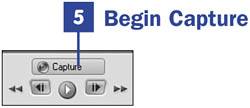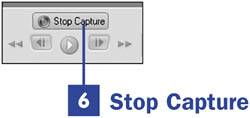5. Capture Digital Video Using FireWire  BEFORE YOU BEGIN BEFORE YOU BEGIN
4 About Video Capture 7 Control Your DV Camcorder During Capture
 SEE ALSO SEE ALSO
9 Capture Video or Audio Only 10 Capture to the Timeline or Media Panel 11 View Captured Clips 12 About Troubleshooting Capture Problems
Initially an Apple brand name, the word FireWire has become standard shorthand for an OHCI-Compliant IEEE-1394 high-speed data connection. (Sony calls their IEEE-1394 port iLink.) FireWire connections are fast and, what's more, they're consistently fast. In fact, when it comes to capturing, outputting, or otherwise exchanging data between your camcorder and your computer, there's almost no substitute (with the possible exception of the new USB video standard). Capturing video into your computer and outputting data from your computer to your camcorder are two of the most processor-intensive tasks a computer can do, and you need a fast, consistent, uninterrupted data flow or it's not going to work. This is why an IEEE-1394 cable and port is the preferred method for getting digital video, or DV, from your camcorder and back again. (In fact, even when digitizing analog video with a piece of third-party software, FireWire is the preferred method for connecting the digitizer to the computer. (See 8 Capture Analog Video.) 1. | Connect Your Camcorder
All MiniDV and Digital8 camcorders have a FireWire connection, even if an IEEE-1394 cable wasn't included with the camcorder when you bought it.
Although the risk of a surge damaging your equipment is low, it's best to turn off your camcorder when you connect the cable between your camcorder and your computer. After the two devices are connected, however, set your camcorder to the VTR mode. Windows registers the connection, usually with a sound effect. A connection icon also appears in the lower-right corner of your Windows taskbar. (See 12 About Troubleshooting Capture Problems.)
5. Capture Digital Video Using FireWire  

 NOTES NOTES
If your computer doesn't have a FireWire port and you plan to do any serious video editing, particularly with digital video, a FireWire card is one of the best investments you can make. Virtually any OHCI-Compliant IEEE-1394 card will work. Some even come with a free FireWire cable. A display at the top of the Capture Monitor panel estimates how much room you have to store captured video on your hard drive. It's important to note, however, that it's impossible to fill a hard drive. When free space on your drive gets pretty low, you probably won't be able to continue to capture video.  TIP TIP
Windows might not be able to detect a connected camcorder unless the camcorder is also connected with an AC adaptor to a power source. | 2. | Open the Capture Workspace
Often, simply connecting your camcorder automatically opens the Capture workspace. Otherwise, clicking the Capture button in the upper-right corner of any Premiere Elements workspace will open it.
| 3. | Locate the Video to Capture
By using Premiere Elements' playback and shuttle controls to operate your camcorder (see 7 Control Your DV Camcorder During Capture), locate a scene on your videotape you want to capture to your computer. Pause the video where you want to begin capture.
 TIP TIP
Ideally, capturing video, as well as outputting video back to your camcorder, is a simple process. However, occasionally it doesn't go as smoothly as it should. If you're having problems, such as dropped frames or interruptions, or you simply can't get Premiere Elements to connect to your camcorder, see 12 About Troubleshooting Capture Problems. | 4. | Name Your Clip Series
In the Clip Name space at the upper-left corner of the Monitor panel, drag to select the name (which defaults to the name of your video project) and give it a name.
As Premiere Elements breaks this captured sequence into short clips, these clips are automatically given the names you specify here followed by a numerical sequence beginning with 01, then 02, and so on.
 NOTE NOTE
By default, Premiere Elements breaks your captured video into clips, based on points at which your camcorder was started and stopped when you initially shot your video. If you'd like to turn off (or on) this feature, click the More button in the Monitor panel and uncheck (or check) the Scene Detect option. | 5. | Begin Capture
Above the playback controls at the bottom center of the Capture workspace is the Capture button. Click the Capture button while your video is paused, and capture begins as your video plays in the Monitor.
It's also possible to simply click the Capture button while your camcorder video is playing. However, the capture process takes a few seconds to start up, and you might miss a key moment. To ensure that your capture is beginning where you want it to begin, it's best to always begin your capture from the video's paused state.
| 6. | Stop Capture
Click the Stop Capture button when you want your capture to stop. Your camcorder returns to pause mode and your clip or clips are automatically added to the Media panel. To review your captured clips, see 11 View Captured Clips.
For custom captures, see 9 Capture Video or Audio Only and 10 Capture to the Timeline or Media Panel.
|
|
 BEFORE YOU BEGIN
BEFORE YOU BEGIN SEE ALSO
SEE ALSO


 NOTES
NOTES